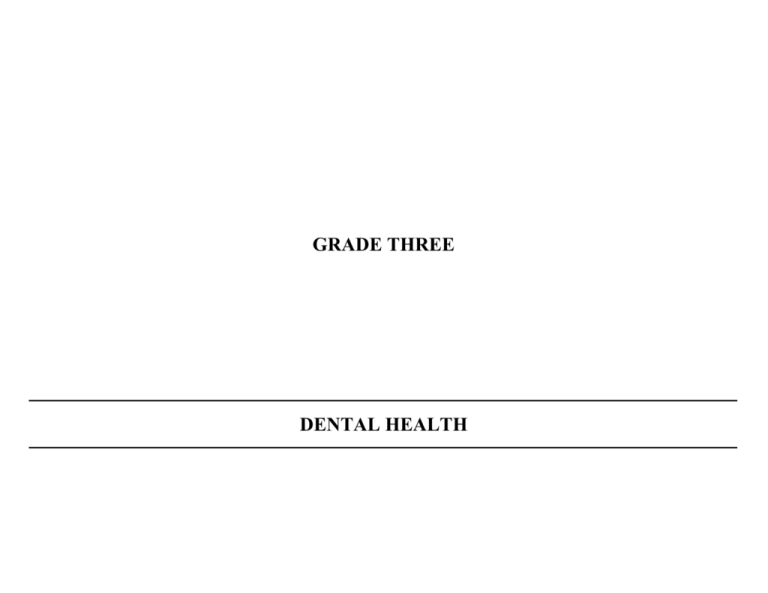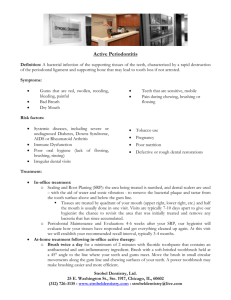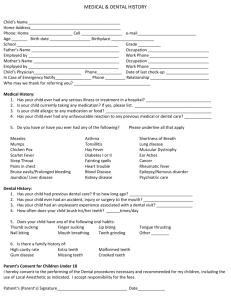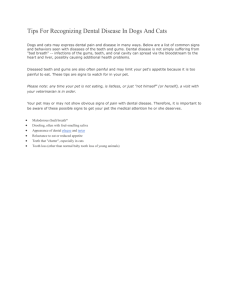GRADE THREE DENTAL HEALTH
advertisement

GRADE THREE DENTAL HEALTH DENTAL HEALTH GRADE: 3 LESSON: 1 THEME: STRUCTURE AND FUNCTION CONCEPT: TEETH HAVE MANY FUNCTIONS PREPARATION: 1 2 3 4 5 6 Several mirrors A copy of the three different kinds of teeth (Activity Sheets D21 A, 21 B and 21 C) Prepare a class set of the 'Different Kinds of Teeth' worksheet (Activity Sheet D22A) Prepare several copes of 'What Do My Teeth Dog' (Activity Sheet D23) Prepare a class set of the 'My Teeth' crossword puzzle (Activity Sheet D24A) Prior to the lesson, invite an elder to the class to discuss and demonstrate functions of the teeth in a traditional lifestyle VOCABULARY: incisor, cuspid, molar OBJECTIVES STUDENT ACTIVITIES TEACHER NOTES Students will be able to: Students: Background Information D56 to D63 i) 1. Examine their own teeth and note the three different kinds of teeth and where they are located Refer to Activity Sheets D21 A, 21 B and 21 C identify specific tooth groups and their locations Have students look in mirrors and find three kinds of teeth and their locations Show students the teeth models and introduce them to the names Point to where each kind is found in the mouth It is not important for students to remember the names 2 Complete the 'Different Kinds of Teeth' worksheet Refer to Activity Sheet D22A Refer to Activity Sheet D22B for answers D1.1 OBJECTIVES STUDENT ACTIVITIES TEACHER NOTES Have students colour each kind of tooth a different colour e g , incisors - red cuspids - blue molars - green ii) identify the function of each tooth group 3 Describe each tooth group according to shape, size, location and function Have students brainstorm words to describe each tooth group in relation to shape, size, location and function Record student responses on an experience chart as illustrated D1.2 OBJECTIVES STUDENT ACTIVITIES 4 Match each tooth group with its function TEACHER NOTES Refer to Activity Sheet D23 Give half of the students one of the tooth models Give the other half one of the function cards Ensure that you distribute an equal number of tooth models and their functions Students have to find their partner i e , match the tooth model with its function 5 Complete the crossword puzzle, 'My Teeth' Refer to Activity Sheet D24A Refer to Activity Sheet D24B for answers. 6 Describe the general functions of the teeth Teeth are important for - talking (proper pronunciation) - eating - the way we look 7 Listen to an elder tell how teeth are used in a traditional lifestyle Prior to the lesson, invite an elder in the community to class to discuss use of teeth in a traditional lifestyle Examples include - softening skins for clothing - holding fishing lines 8 Observe a demonstration of chewing skin Have an elder demonstrate one of the examples which s/he has discussed with the class e g , chewing skin D1.3 D21 A TOOTH MODEL incisor D21 B TOOTH MODEL cuspid D21 C TOOTH MODEL molar D22A DIFFERENT KINDS OF TEETH Colour incisors red. Colour cuspids blue. Colour molars green. D22B DIFFERENT KINDS OF TEETH (Teacher Answer Guide) Colour incisors red. (I) Colour cuspids blue. (C) Colour molars green. (M) D23 WHAT DO MY TEETH DO? cuts, bites, tears tears crushes, chops up, chews D24A MY TEETH Across 1. my front teeth do what scissors do 2. what you have in your mouth when your tooth falls out 3. my front teeth do this 4. my side teeth, do this Down 1. my back teeth do this 2. when you're happy, you do this D24B MY TEETH (Teacher Answer Guide) DENTAL HEALTH GRADE: 3 LESSON: 2 THEME: ORAL HYGIENE CONCEPT: REGULAR USE OF ORAL HYGIENE SKILLS PROMOTES DENTAL HEALTH PREPARATION: 1. 2 3 4 Enough floss for all the students in the class Enough toothbrushes and toothpaste for all the students in the class A large dentiform model Prepare a class set of the 'Caring For My Teeth' worksheet (Activity Sheet D25) VOCABULARY: OBJECTIVES STUDENT ACTIVITIES TEACHER NOTES Students will be able to: Students: Background Information Page D39 to D46 Teeth need to be thoroughly flossed and brushed once a day i) demonstrate effective toothbrushing and flossing skills 1. Observe a demonstration of effective flossing skills Demonstrate effective flossing skills, using a large dentiform model and floss (If a dental therapist is available in the community, invite the therapist to give the demonstration ) 2 Demonstrate effective flossing skills Have students take turns demonstrating effective flossing skills on the dentiform model 3 Observe a demonstration of effect toothbrushing skills Review with students effective toothbrushing skills 4 Demonstrate effective tooth brushing skills Have students take turns demonstrating effective toothbrushing skills D2.21 OBJECTIVES ii) practise effective tooth brushing and flossing skills STUDENT ACTIVITIES TEACHER NOTES 5 Explain when to floss and brush Floss before brushing to remove food debris from between the teeth so that it can be brushed away. Many people floss and brush after eating and before bedtime 6 Discuss ways to clean the teeth if unable If unable to brush the teeth after eating, people can to brush and floss - rinse the mouth with water - eat crispy foods such as apple, celery, raw carrot, raw turnip, raw cabbage 7 Keep a record of dental health behaviours for one week Refer to Activity Sheet D25 Have students practise daily flossing, brushing,, rinsing and eating of crunchy food at home for one week Students should keep a record of their dental health behaviours Have the students bring the sheet back at the end of the week Discuss 8 Practise daily flossing and brushing skills at school Teachers are encouraged to have a flossing and brushing program at school throughout the year Teachers can use weekly/monthly dental charts to record student dental behaviours Teachers are encouraged to participate with the students D2.22 D25 CARING FOR MY TEETH good Now draw a picture in the box each time you floss, brush, rinse or eat a crunchy food to help keep your teeth clean. toothbrush. I have a(n) old MON TUES WED THURS FRI SAT SUN Brush Floss Rinse Eat crunchy food I brushed my teeth I flossed my teeth I rinsed my mouth I ate crunchy food ________ _________ _________ __________ times times times times _____ _____ _____ _____ times times times times _____ _____ _____ _____ times times times times _____ _____ _____ _____ times times times times _____ _____ _____ _____ times times times times _____ _____ _____ _____ times times times times _____ _____ _____ _____ times times times times DENTAL HEALTH GRADE: 3 LESSON: 3 THEME: DENTAL DISEASE CONCEPT: MANY FACTORS CONTRIBUTE TO DENTAL DISEASE PREPARATION: 1 2 3 4 5 5 Enough disclosing tablets and floss for all the students Prepare a class set of the 'Where We Find Plaque' worksheet (Activity Sheet D26A) Samples of acidic foods e g , dill pickles, unripe berries Make an enlarged drawing of the 'Tooth Decay' diagram (Activity Sheet D26B) A copy of 'Bertha's Story' (Activity Sheet D27) Materials for the 'Tommy - The Bad Tooth' story VOCABULARY: plaque, grooves, germs, acid, tooth decay OBJECTIVES STUDENT ACTIVITIES TEACHER NOTES Students will be able to: Students: Background Information Page D39 to D46 i) identify the location plaque in the mouth 1. Chew a disclosing tablet and observe the location of plaque in their mouths Distribute disclosing tablets to the students and observe where plaque occurs in their mouths D3.25 OBJECTIVES STUDENT ACTIVITIES TEACHER NOTES 2 Describe how plaque is formed Plaque forms when germs come in contact with small pieces of food. People can sometimes feel plaque on their teeth Run the tongue along the teeth. If it feels rough, that is plaque 3 Complete the 'Where We Find Plaque' worksheet Refer to Activity Sheet D26A 4 Scrape plaque from the teeth using dental floss and observe it Distribute dental floss to students. Have them floss their teeth to remove some plaque Ask students to describe the plaque Plaque is a white, sticky substance. ii) explain how plaque contributes to tooth decay 5. Sample certain foods and describe the taste Have students sample acidic foods such as dill pickles, unripe berries, strong tea They will taste sour The sour taste is the acid m their mouth 6 Refer to Activity Sheet D26B Explain how tooth decay occurs. Ask students if they have ever had a bad tooth Discuss Make an enlarged drawing of the tooth decay sheet Use it to explain how tooth decay occurs (Most acids have corrosive warning signs on them, this may help students understand what an acid is and can do.) 7 List the key words involved in tooth decay Key words include- D3.26 OBJECTIVES iii) STUDENT ACTIVITIES identify some 8 Brainstorm factors that lead to dental disease factors that contribute to dental disease TEACHER NOTES Refer to Activity Sheet D27 Read 'Bertha's Story' to the students Have them identify from the story factors that lead to dental disease Some factors are: - dental injuries (broken teeth) - build-up of plaque - poor brushing and flossing - not brushing and flossing every day - lots of sugar - sticky foods - not having regular check-ups with the dental health worker 9 Write a story about 'Tommy – The Bad Tooth' Read the story again, have students raise their hand every time Bertha does something which leads to dental disease Discuss Have students write a story about a rotten tooth The story should include - that the tooth used to be healthy - what things helped to make it bad The book should be a 'shape' book Eg , Save books and some blank pages for the next lesson D3.27 D26A WHERE WE FIND PLAQUE On each tooth, colour where you find plaque. Finish each sentence. We find plaque On __________________________ __________________________ between ________________________ ___________________________ and near ___________________________ D27 BERTHA'S STORY Bertha is 8 years old. She does the same things as most 8 year olds. She plays with her friends, eats junk food, watches T.V. and leaves her things lying around the house. Last night, in the dark, Bertha tripped over her boots and fell flat on her face. She broke a tooth! The next day she went with her mother to the dental office. Janet, the dental worker, said "Oh, Bertha! You haven't been here for a long time. Let me look at your teeth. Mm! Your teeth are not very clean. When did you brush them?" "Two days ago" whispered Bertha. "When did you floss them?" "I don't remember" said Bertha. "You know," said Janet "it's very important to look after your teeth. If you look after them properly, you'll have good teeth for your whole life. If you don't, you'll have problems with them. The choice is yours!" D26B TOOTH DECAY DENTAL HEALTH GRADE: 3 LESSON: 4 THEME: DENTAL SERVICES AND PRODUCTS CONCEPT: INDIVIDUALS AND DENTAL HEALTH WORKERS ARE IMPORTANT IN DENTAL HEALTH CARE PREPARATION: 1 A copy of the book 'Ours For A Lifetime' - available in all schools or from the Otto Schaefer Resource Library, Yellowknife 2 Prior to the lesson, arrange for the class to visit the dental clinic or arrange for a dental health worker to visit the class VOCABULARY: responsible OBJECTIVES STUDENT ACTIVITIES TEACHER NOTES Students will be able to: Students: Background Information Page D39 to D46 i) 1. Brainstorm things they can do to help prevent dental disease Refer to Bertha's story from the previous lesson identify ways to be personally responsible for dental health care Ways to prevent dental disease include: - playing safely near dental hazards - removing plaque every day - brushing and flossing three times a day - brushing/flossing/rinsing after eating - not eating food with a lot of sugar or sticky food - having regular check-ups with the dental health worker ii) explain the roles of community dental health workers 2 Listen to the story 'Ours For A Lifetime'. Read the story to the students. Discuss. D4.35 OBJECTIVES STUDENT ACTIVITIES TEACHER NOTES 3 Describe what the dental health worker in the story does. Have students discuss the role of the dental health worker Have students respond using the sentence pattern: 4 Visit a dental office or have a visit from a dental health worker Prior to the lesson, arrange for a visit to the dental clinic or ask the dental health worker to come to the class to describe the different tasks s/he performs. 5 Finish the story 'Tommy - The Bad Tooth' Have students finish the story from the previous lesson by adding - what things Tommy's owner could have done to help keep him healthy for a lifetime - how the dental health worker could help Tommy D4.36








